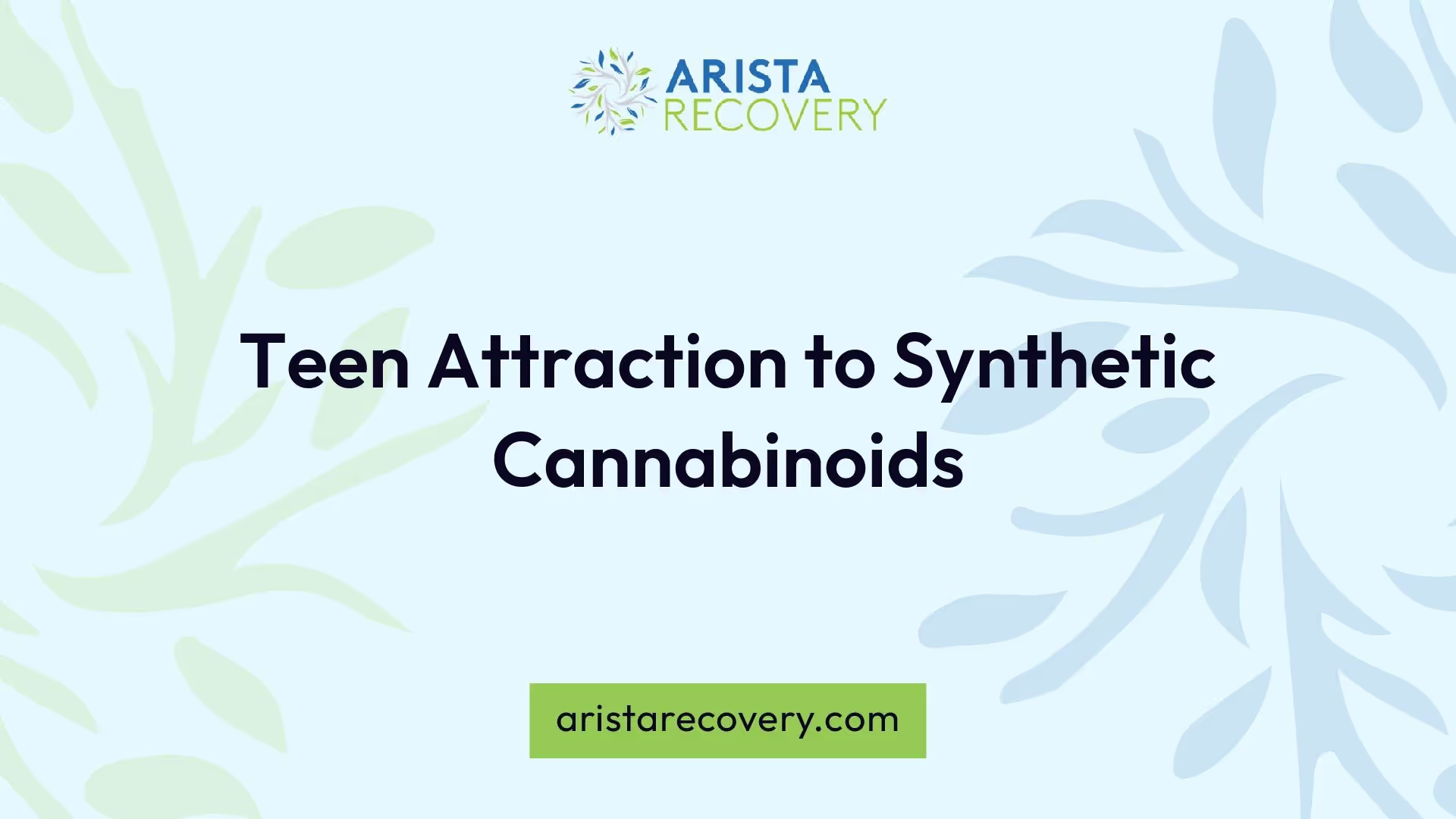What Drives Teen Attraction to K2 Drug Abuse?

Understanding Synthetic Cannabinoids
In order to comprehend the impact of synthetic cannabinoids like K2 on individuals, it is essential to explore the health effects and implications on physical health associated with these substances.

Health Effects of Synthetic Cannabinoids
Synthetic cannabinoids, such as K2/Spice, have been linked to severe health effects that can be life-threatening. These effects include acute liver failure, cardiac arrest, toxic leukoencephalopathy, profound hypotension, and bradycardia [1]. The potency of synthetic cannabinoids, particularly those found in K2, is up to five times stronger than natural marijuana, making them appealing to teenagers seeking a more intense high.
Impact on Physical Health
The misuse of synthetic cannabinoids can have detrimental effects on physical health, leading to conditions such as heart damage from myocardial ischemia, renal damage, and seizure activity [2]. Additionally, these substances have been associated with cardiovascular issues such as tachycardia, hypertension, and chest pain, posing significant risks to the overall well-being of individuals who engage in their consumption.
Understanding the profound impact that synthetic cannabinoids can have on both physical and mental health is crucial in addressing the dangers associated with these substances. By shedding light on the health effects and physical consequences of synthetic cannabinoids like K2, it becomes evident why proactive measures are necessary to prevent and combat the negative repercussions of their misuse.
Teen Attraction to Synthetic Cannabinoids

As the popularity of synthetic cannabinoids, such as K2 or "Spice," among teenagers continues to rise, it becomes essential to understand the factors that drive adolescents towards drug abuse.
Factors Influencing Drug Use
Synthetic drugs like K2 have gained traction among teens primarily due to their easy accessibility, affordability, and the perceived intensified high they offer compared to natural cannabis. The synthetic cannabinoids in K2 mimic the effects of marijuana intoxication, making them appealing to adolescents seeking a potent and alternative experience.
The appeal of synthetic cannabinoids is also boosted by the fact that they are often difficult to detect in traditional urine drug screenings, providing a sense of invisibility to users. This elusive quality further contributes to the attraction of teens towards these substances.
Risk Factors for Adolescents
Several risk factors contribute to the vulnerability of adolescents to synthetic cannabinoid abuse. Statistics indicate a concerning increase in substance use among 12- to 17-year-olds in the U.S., with approximately 2.08 million individuals in this age group admitting to recent drug use.
Certain demographic factors also play a significant role in the likelihood of K2 consumption among teenagers. Research suggests that male adolescents aged 16 to 17 years, particularly those residing in urban areas, are at a higher risk of engaging in the use of synthetic marijuana. These demographic indicators serve as red flags for identifying adolescents who may be more inclined to experiment with synthetic cannabinoids like K2.
By unraveling the various factors that influence teen attraction to synthetic cannabinoids and recognizing the risk factors associated with adolescent drug abuse, we can better address and combat the growing epidemic of K2 abuse among youth. Education, awareness, and targeted interventions are critical in safeguarding adolescents against the dangers posed by synthetic drug consumption.
The Rise of K2 Abuse
As the issue of K2 drug abuse continues to garner attention, it is crucial to analyze the statistics and trends associated with its use, as well as the impact on emergency department visits.
Statistics and Trends
The prevalence of synthetic cannabinoids, like K2/Spice, has witnessed a concerning surge in recent years. According to the National Center for Drug Abuse Statistics, between 2010 and 2011, the estimated number of emergency department visits involving synthetic cannabinoids more than doubled. This drastic increase underscores the growing prevalence of K2 usage and its associated risks.
A notable trend observed is that synthetic cannabinoids were implicated in a significant majority (65%) of emergency department visits by patients aged 20 or younger in 2011. The data indicates a concerning pattern of K2 abuse among adolescents and young adults, emphasizing the need for targeted interventions and education to address this issue effectively.
Emergency Department Visits
The surge in the use of synthetic cannabinoids like K2 has directly translated into an increase in emergency department visits due to adverse health events. In 2010, the American Association of Poison Control Centers reported over 2500 calls related to K2, a drastic rise from just 53 calls in 2009. The adverse effects associated with smoking K2 include hallucinations, severe agitation, elevated heart rate, coma, and the risk of drug dependence [3].
These emergency department visits serve as a stark reminder of the grave consequences of synthetic cannabinoid abuse and highlight the urgent need for preventative measures and interventions to combat the rise in K2-related health crises. Addressing the underlying factors driving K2 abuse among teens is crucial to mitigating its detrimental impact on individuals, families, and communities.
Psychological Impact of Synthetic Cannabinoids
The use of synthetic cannabinoids, such as K2 and Spice, among teenagers can have profound effects on mental health and cognitive functioning. Understanding the psychological impact of these substances is crucial in addressing the challenges associated with teen drug abuse.
Mental Health Consequences
Synthetic cannabinoids have been linked to serious mental health consequences, including an outbreak of synthetic cannabinoid-associated coagulopathy, psychosis, suicidal ideation, and suicide attempts among users. Teenagers who abuse substances like K2 are at a significantly higher risk for mental health issues, such as depression, conduct problems, personality disorders, and suicidal tendencies. The impact on mental health can be debilitating, affecting not only the individual's well-being but also their relationships and overall quality of life.
Cognitive Effects
In addition to the mental health consequences, synthetic cannabinoids can have detrimental effects on cognitive functioning. These substances can impact short-term memory, learning abilities, and psychomotor skills, which are essential for academic performance and daily activities. The use of synthetic cannabinoids like K2 and Spice has been associated with impaired cognitive function, posing challenges for adolescents in school and other areas of life.
Studies have shown that exposure to synthetic cannabinoids during adolescence can lead to neurobiological changes that affect brain function. For instance, in male mice, exposure to JWH-018 induced activation of microglia and astrocytes in the prefrontal cortex, resulting in neurobiological alterations associated with psychotic-like symptoms and sensorimotor impairments. These findings underscore the importance of recognizing the cognitive risks associated with synthetic cannabinoid abuse among teenagers.
By understanding the psychological impact of synthetic cannabinoids, we can better address the complex challenges posed by teen drug abuse. It is essential to prioritize mental health and cognitive well-being in prevention and intervention strategies aimed at mitigating the harmful effects of synthetic cannabinoid use among adolescents.
Prevention and Intervention Strategies
In combatting the allure of K2 drug abuse among teenagers, effective prevention and intervention strategies play a pivotal role. By addressing the underlying factors that contribute to substance abuse and implementing targeted initiatives, it is possible to mitigate the risks associated with this dangerous behavior.
Substance Abuse Prevention Programs
Substance abuse prevention programs are essential in educating adolescents about the risks and consequences of drug abuse. One notable program is the Life Skills Training (LST) program, a universal initiative that equips students with drug resistance skills, personal self-management skills, and general social skills to deter substance use. Implemented during the middle school years, the LST program has demonstrated significant effectiveness in preventing the use of substances like cigarettes, alcohol, and marijuana.
Another impactful program is Project Towards No Drug Abuse (TND), specifically tailored for high-risk students in high school. This program integrates motivational activities, social skills training, and decision-making components to empower students to resist substance use and abuse. Through the implementation of such programs, reductions in rates of hard drug use, alcohol consumption, and risky behaviors can be achieved, fostering a healthier and safer environment for adolescents.
Educational Initiatives
Educational initiatives play a crucial role in raising awareness and promoting healthy decision-making among teenagers. By enhancing knowledge about the risks associated with K2 drug abuse and providing accurate information about the consequences of substance use, educational programs can empower adolescents to make informed choices regarding their health and well-being.
These initiatives should address the multiple levels of influence that contribute to substance abuse, including individual, family, school, and community factors [6]. By targeting these diverse influences, educational programs can effectively address the root causes of drug abuse and cultivate a supportive environment that discourages risky behaviors.
It is imperative that prevention efforts focus on current substance use, including K2/Spice, among college students, as highlighted by research [7]. Understanding the risk factors associated with K2/Spice use, such as sensation-seeking behavior and prior drug experimentation, can inform the development of tailored educational initiatives that resonate with this at-risk population.
By investing in substance abuse prevention programs and educational initiatives, communities can work together to safeguard the well-being of teenagers and steer them away from the dangers of K2 drug abuse. Empowering youth with knowledge, skills, and support is key to creating a generation that is resilient against the allure of harmful substances and equipped to make positive choices for their future.
Future Implications
As the repercussions of synthetic cannabinoid abuse, particularly K2, continue to unfold, it is vital to consider the potential future implications, focusing on the long-term health risks and regulatory measures necessary to combat this issue effectively.
Long-Term Health Risks
Research has shown that exposure to synthetic cannabinoids like JWH-018 during adolescence can result in long-lasting neurobiological changes that are linked to psychotic-like symptoms, indicating significant long-term health risks. Adolescent consumption of synthetic cannabinoids has also been associated with an increased risk of developing psychiatric disorders in later life, underscoring the serious long-term health consequences of synthetic cannabinoid use.
Moreover, factors such as sensation-seeking behavior have been identified as predictors of lifetime K2/Spice use, signaling potential long-term health risks associated with synthetic cannabinoid usage [7]. The rise in substance use among adolescents in the U.S. further highlights the urgent need to address the long-term health risks associated with synthetic marijuana abuse.
Regulatory Measures
To address the escalating issue of synthetic cannabinoid abuse, stringent regulatory measures must be implemented. These measures should focus on restricting access to synthetic cannabinoids, enhancing monitoring and enforcement efforts, and increasing public awareness about the dangers associated with these substances.
Regulatory bodies need to collaborate with healthcare professionals, law enforcement agencies, and educational institutions to establish comprehensive policies that control the manufacturing, distribution, and sale of synthetic cannabinoids. By enforcing strict regulations, authorities can curb the availability of these substances and prevent their misuse among vulnerable populations, especially adolescents.
Furthermore, public health campaigns and educational programs should be launched to educate individuals about the risks of synthetic cannabinoid abuse and promote healthy alternatives. Increasing awareness among teenagers, parents, and educators about the dangers of synthetic cannabinoids is a crucial step towards preventing future cases of substance abuse and mitigating the long-term health implications associated with these harmful substances.
By prioritizing long-term health considerations and implementing effective regulatory measures, society can work towards safeguarding the well-being of adolescents and combating the detrimental effects of synthetic cannabinoid abuse in the years to come.
References
[2]:
[3]:
[4]:
[5]:
[6]:
[7]:
We are here for you
You’ve taken the first steps, let us take you further. Arista Recovery is committed to ensuring that individuals and families impacted by substance use receive best in class care.








.jpg)
.jpg)
